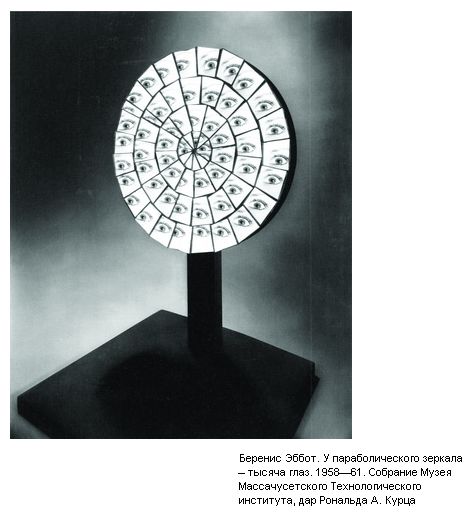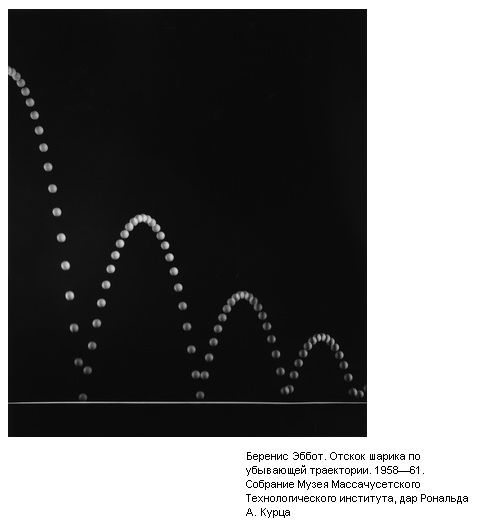Беренис Эббот (англ. Berenice Abbott; 17 июля 1898 — 9 декабря 1991) — американский фотограф, получившая известность прежде всего благодаря фотографиям Нью-Йорка 1930-х годов. Эббот принято считать первой женщиной-фотографом, сумевшей добиться широкой известности в этой традиционно мужской профессии[1].
читать дальше
science photography
While working on her photography, Berenice became intrigued by science and studied physics, chemistry, and engineering on her own. In order to capture motions that are too fast or too detailed for the human eye, she even invented special equipments to make the imaging possible, which she called “Super Sight.” Through these endeavors, she became interested in the possibility of the union between art and science, which she explored using photography as the medium.
What made Berenice stand out among other modernist photographer of her time was that she insisted on the “accurate portrait of scientific phenomena” (in her own words) rather than creating good-looking designs out of scientific concepts (such as wave patterns).
Berenice worked two years at MIT, where she produced portraits of the principles of physical sciences, including mechanics, electromagnetism, and waves. Her scientific photography that portrays the physical phenomena appeared in textbooks and helped high school students to visualize the phenomena in much more conveying way than illustrations. These include a photograph of a ball bouncing in smaller and smaller arcs, demonstrating the physical effect of gravity.
Berenice writes, “There needs to be a friendly interpreter between science and the layman.” I hope to achieve this through writing this blog, as Berenice did through her photography.
в 1940-е годы Беренис Эббот, к тому времени уже опытный мастер, фоторедактор журнала Science Illustrated, получила град издевательских отзывов из ученой среды за свои попытки снимать физико-химические процессы.
Формальными причинами для остракизма были якобы академические неточности, допущенные автором в ходе этих специфических фотосессий, но сама Беренис была уверена, что все дело в сексизме.
И с удвоенным упрямством продолжила снимать научные эксперименты и иллюстрации к законам природы.
Неуступчивость принесла свои плоды: в 1958 году комитет по изучению физических наук при Массачусетском технологическом институте пригласил Беренис Эббот создать серию визуальных материалов для нового школьного учебника. К слову, тогдашний мозговой штурм по всем научным направлениям случился в США после запуска первого советского спутника Земли:
власти забили тревогу из-за возможного отставания от русских и спешно бросились подтягивать техническое и естественно-научное образование.
Эббот тоже подключили к процессу, и два с половиной года она работала над фотографической серией «Образ физики»


читать дальше
science photography
While working on her photography, Berenice became intrigued by science and studied physics, chemistry, and engineering on her own. In order to capture motions that are too fast or too detailed for the human eye, she even invented special equipments to make the imaging possible, which she called “Super Sight.” Through these endeavors, she became interested in the possibility of the union between art and science, which she explored using photography as the medium.
What made Berenice stand out among other modernist photographer of her time was that she insisted on the “accurate portrait of scientific phenomena” (in her own words) rather than creating good-looking designs out of scientific concepts (such as wave patterns).
Berenice worked two years at MIT, where she produced portraits of the principles of physical sciences, including mechanics, electromagnetism, and waves. Her scientific photography that portrays the physical phenomena appeared in textbooks and helped high school students to visualize the phenomena in much more conveying way than illustrations. These include a photograph of a ball bouncing in smaller and smaller arcs, demonstrating the physical effect of gravity.
Berenice writes, “There needs to be a friendly interpreter between science and the layman.” I hope to achieve this through writing this blog, as Berenice did through her photography.
в 1940-е годы Беренис Эббот, к тому времени уже опытный мастер, фоторедактор журнала Science Illustrated, получила град издевательских отзывов из ученой среды за свои попытки снимать физико-химические процессы.
Формальными причинами для остракизма были якобы академические неточности, допущенные автором в ходе этих специфических фотосессий, но сама Беренис была уверена, что все дело в сексизме.
И с удвоенным упрямством продолжила снимать научные эксперименты и иллюстрации к законам природы.
Неуступчивость принесла свои плоды: в 1958 году комитет по изучению физических наук при Массачусетском технологическом институте пригласил Беренис Эббот создать серию визуальных материалов для нового школьного учебника. К слову, тогдашний мозговой штурм по всем научным направлениям случился в США после запуска первого советского спутника Земли:
власти забили тревогу из-за возможного отставания от русских и спешно бросились подтягивать техническое и естественно-научное образование.
Эббот тоже подключили к процессу, и два с половиной года она работала над фотографической серией «Образ физики»


